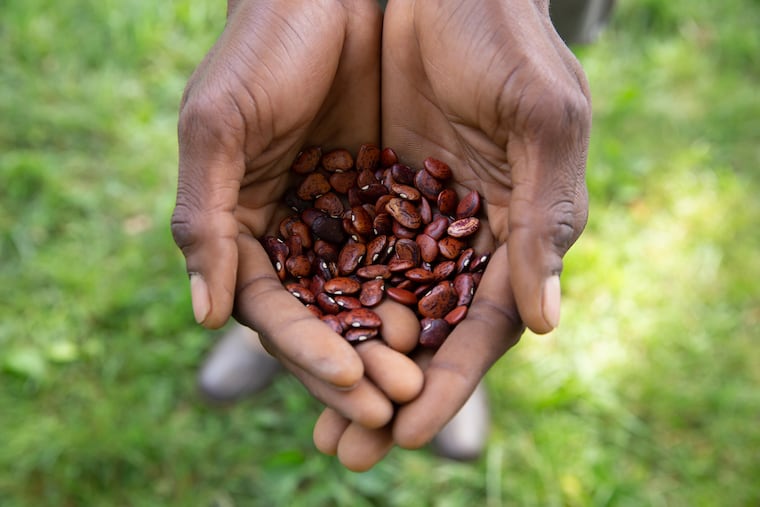The pandemic caused a seed shortage. Here’s how to save them.
You don't have to be a farmer to take control of next year's harvest — even if it's just in your window box.

“The more you spend time with your plants, the more you develop a relationship with them,” says Owen Taylor, founder of Truelove Seeds.
The local seed company works with small farmers to cultivate and preserve not only rare seeds but also the stories and cultural significance behind them. It’s the difference, Taylor says, between seed-saving and seed-keeping (which is also Taylor’s Instagram handle, sans the hyphen).
Many of Truelove’s elusive seeds — for black peanuts, Paul Robeson tomatoes, Clemson spineless okra, Georgia rattlesnake watermelons — have been snapped up for the year. Taylor says the pandemic led to an unexpected shortage; about half of Truelove’s inventory sold out, and he’s even had trouble finding certain products.
But you don’t need to buy seeds. Even one tomato plant or a window box can provide enough for next year. Taylor walked us through the basics of seed-saving and why it’s worth the effort.
What kind of space do potential seed-savers need to have?
If you’re growing anything to eat, you have enough space to save seeds, too. Let’s say someone’s growing one tomato in a pot on their deck. They may want to consider saving seeds from even just one tomato — the one that’s the most beautiful, tastiest — so that next year hopefully they have an even better harvest. I always tell people to just do it, and you get some major successes, you get some failures. But that’s true with all gardening.
Let’s say you have a window box with herbs. Would that work?
You can save your herbs' seeds. As you watch them go to flower, watch the stem. As it starts to brown and turn dry, you know that it’s finished feeding the next generation. And you can snip that seed head off once it turns dry and brown. Coax out the seeds with your fingers and sift out the chaff with a colander, and then you have your seeds for the next year.
» READ MORE: Truelove prizes seeds and stories from around the world
If you’re a starter seed-saver, what’s the easiest plant to start with?
Beans, peas. Anything in a pod. You just wait for the pod to dry out on the plant. You’re thinking about what stage that’s done pulling nourishment from the parent. And for something like beans, you look for it to get crispy and crunchy; it’s as mature as it’s gonna get then. Pull it off and shell it and save those seeds.
Tomatoes are like the gateway vegetable, even though it’s a fruit. There are really easy ways to save their seeds. I do a more complicated ferment method that helps increase the germination rate, does a little disease control, and makes it easier to clean the protective gel coating off the seeds, but some people can be intimidated by it.
Walk us through the process of seed-saving a tomato.
You want to pick the healthiest plants with the least signs of disease, because you’ve become at this point a plant breeder. You’re selecting how the fruit will look in the future, so pick the perfect fruit. Pick it at ultimate ripeness; you want a seed to get as much of what it needs from the mother plant before you pick it. Luckily we eat tomatoes at the same stage where they are most ripe.
Squeeze the seeds out in a jar. What I like to do is put either a paper towel or some kind of breathable fabric with a rubber band or a string over the jar lid so that no flies lay their eggs in there. And I label it with the name and the date so I know, three to four days later, it’s fermented enough to go in and stir up.
Add water to the top of the jar so that the good seeds all sink to the bottom, and all of that kind of icky stuff goes to the top. If you see mold, that’s good. The mold is a sign that it’s done its job. Then you pour off all the floating stuff carefully, leaving the sunken good seeds behind. Repeat that step three, four times until what’s left is absolutely clear water and heavy beautiful seeds. Then you strain it out. Get as much water out as you can. Lay it out to dry on paper bags, parchment paper, or a ceramic plate — something that the seeds won’t stick to.
Then dry them for a couple weeks. Find a space that’s out of the sun with some airflow, maybe a fan or dehumidifier. We put the date on that too, so we know when it’s really dry. If they stay wet in storage, they’re going to mold and rot and become unusable.
And that’s it. Put them in a jar with a screw-top so nothing crawls in there, and keep them in a cool, dark place, well-labeled, for next year. You want them to be fully dormant, not being stimulated by moisture or sun. That’ll keep them sleeping until it’s time to wake up.
Can regular people be seed-savers and seed-keepers?
Oh yeah, that is who does seed-keeping. It’s kind of an anomaly that at this time, in this place, there are so few people keeping seeds. Around the world, it’s still such a common practice. We’ve benefited a lot, since about 100 years ago, from the increase in small-scale seed companies. But in the 10,000-year history of humans growing food, domesticating food crops, that is the centerpiece of the work: making sure you’re leaving some of your harvest to go to seed so that you have a crop the following year. So it’s certainly something regular people do, and I’m hoping more and more people get back to that.